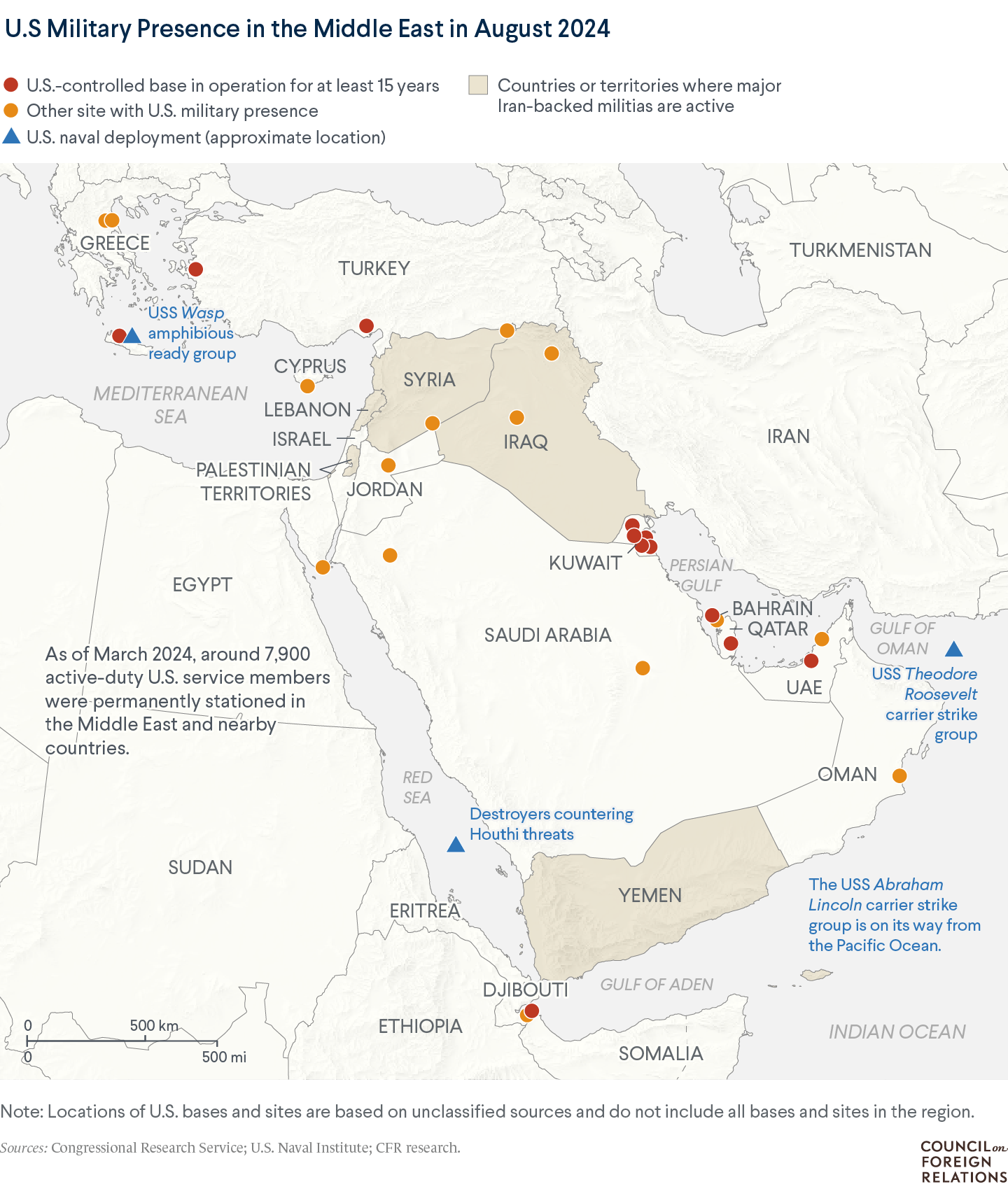The Israel-Hezbollah Conflict: Where It Stands
Cross-border fighting has returned to a lower intensity following Israel’s preemptive strike in Lebanon, but the conflict could escalate again, and a reprisal from Iran remains likely.
August 29, 2024 1:36 pm (EST)
- Expert Brief
- CFR scholars provide expert analysis and commentary on international issues.
How significant was the weekend exchange of attacks between Israel and Hezbollah?
The Israelis have warned since the killing of Hamas leader Ismail Haniyeh and Hezbollah’s leader Fuad Shukr in recent weeks that they would preempt any impending retaliatory attack. That is precisely what happened on Sunday. The Israel Defense Forces (IDF) reportedly targeted six thousand Hezbollah rocket launchers in southern Lebanon in a significant demonstration of both force and technical capability. Even so, Hezbollah was able to launch more than two hundred rockets and drones at northern Israel, causing limited damage.
It seems clear that while the Israelis have not deterred Hezbollah from firing on Israel, the IDF’s demonstration of force against the Lebanon-based militant group over the last eleven months, combined with Sunday’s preemption, have compelled Hezbollah leader Hassan Nasrallah to think twice about launching more significant attacks on central Israel and critical Israeli infrastructure. After declaring Hezbollah’s operation on Sunday a success (it was not), Nasrallah indicated that he would prefer to avoid any further escalation.
What are the chances of a sharp escalation between the two sides, including an Israeli ground offensive?
More on:
Nasrallah’s willingness to de-escalate in this instance should be cold comfort to policymakers, Israelis, and the Lebanese for two reasons. First, Nasrallah has no intention of ordering Hezbollah to stand down, which means that the cross-border fire and counterfire between the group and the IDF will continue. As a result, about one-hundred-thousand Lebanese and almost as many Israelis will remain forced out of their homes near the two countries’ border for the foreseeable future. Second, Israel’s leaders are determined to push Hezbollah back from the border to the banks of the Litani River, about eighteen miles north. Israel has declared their preference is a diplomatic deal but are prepared to use force to accomplish their goal. Presumably, this would entail a major IDF ground operation.
The Israelis are wary of diplomatic attempts to end the hostilities with Hezbollah, citing UN Resolution 1701 (2006), which, among various other measures, required Hezbollah to be dismantled and prohibited forces other than the Lebanese Army and UN peacekeepers from operating in the territory between the Litani River and the Lebanon-Israel border.
What’s the status of Israel-Iran tensions? Are there still expectations of an Iranian military reprisal for the assassination of Haniyeh?
Israel and Iran are effectively at war. The two countries were engaged in an unconventional conflict years before Hamas’s attack on southern Israel in October 2023. In general, the Israelis got the better of Iran in this “shadow war,” successfully assassinating Iranian nuclear scientists, disrupting Iran’s flow of weapons to Hezbollah, and penetrating Tehran’s nuclear program. Meanwhile, Iran has been supporting their network of anti-Israel proxies in the region.
The region has watched as Ayatollah Ali Khamenei, Iran’s supreme leader, threatened a “punishing” reprisal for the assassination of Haniyeh in Tehran in early August, and as Iranian officials declared on social media that the Islamic Republic will respond at a place and time of its choosing. So while Israel and the United States may have deterred Iran for the moment, Iran will almost certainly retaliate. Still, the deployment of U.S. military power to the region combined with Israel’s own demonstrations of force have convinced the Ayatollah and leaders of the Islamic Revolutionary Guard Corps that the punishment it has promised to dole out could wind up not being worth the likely cost, so now they must rethink how to best avenge Haniyeh.
Is there any expected change to the U.S. role in bolstering Israel’s defense, as well as seeking to spur diplomacy to end the war in the Gaza Strip?
The United States has deployed considerable force to help ensure Israeli security, including two aircraft carriers and large numbers of military aircraft in the region. This show of force is intended to deter Iran and Hezbollah from escalating the conflict further. The United States is also continuing to share intelligence with Israel. If the risks of escalation diminish in the coming weeks, it is likely that the United States will reduce some of its supplemental forces.
More on:

U.S. diplomats continue to work with their Israeli, Egyptian, and Qatari counterparts on a cease-fire. They claim to be close to an agreement that everyone hopes will lead to a de-escalation across all fronts of the conflict. Yet, Hamas and the Israeli government have not been able to come to an agreement. Beyond the question of whether Hamas leader Yahya Sinwar and members of the Israeli government actually want a cease-fire, there are several important sticking points for negotiators to overcome.
The Israelis require that their forces remain in the Philadelpi Corridor, which is on the Egypt-Gaza border. There, the Israelis have found tunnels, which they credibly claim were used to resupply Hamas. The Egyptian government regards Israel’s presence in the area to be a violation of the 2005 Philadelpi Accord, under which the IDF withdrew from the corridor while Egypt established a paramilitary guard to prevent smuggling across its border with Gaza. The Israelis also want to retain access to the east-west Netzarim Corridor, which bisects the Gaza Strip. Hamas, however, demands that all Israeli forces withdraw from the enclave. The other major question remains over whether or not Hamas is willing to satisfy Israel’s demands on the number of hostages to be released as part of an initial phase of a cease-fire.
 Online Store
Online Store
